 If we were asked for a somewhat eye-catching RX Vega64 and if the range of such cards were not so limited, then the Red Devil from Powercolor would come to mind spontaneously. Because it not only applies quite strongly visually, but comes on the market with a rather impressive overall appearance. If it's available.
If we were asked for a somewhat eye-catching RX Vega64 and if the range of such cards were not so limited, then the Red Devil from Powercolor would come to mind spontaneously. Because it not only applies quite strongly visually, but comes on the market with a rather impressive overall appearance. If it's available.
Similar to Sapphire's heavyweight RX Vega64 Nitro+, the Powercolor RX Vega64 Red Devil is a pretty eye-catching card at first glance that likes to make thick jaws. So restraint is not their thing.
With the currently still available Vega64 cards, however, one can no longer distinguish between individual positionings within this chip class due to the really already presusb prices. You can be happy if there is one. Interestingly, availability in Europe is often better than in North America or Asia, for example. The moon prices are left out.
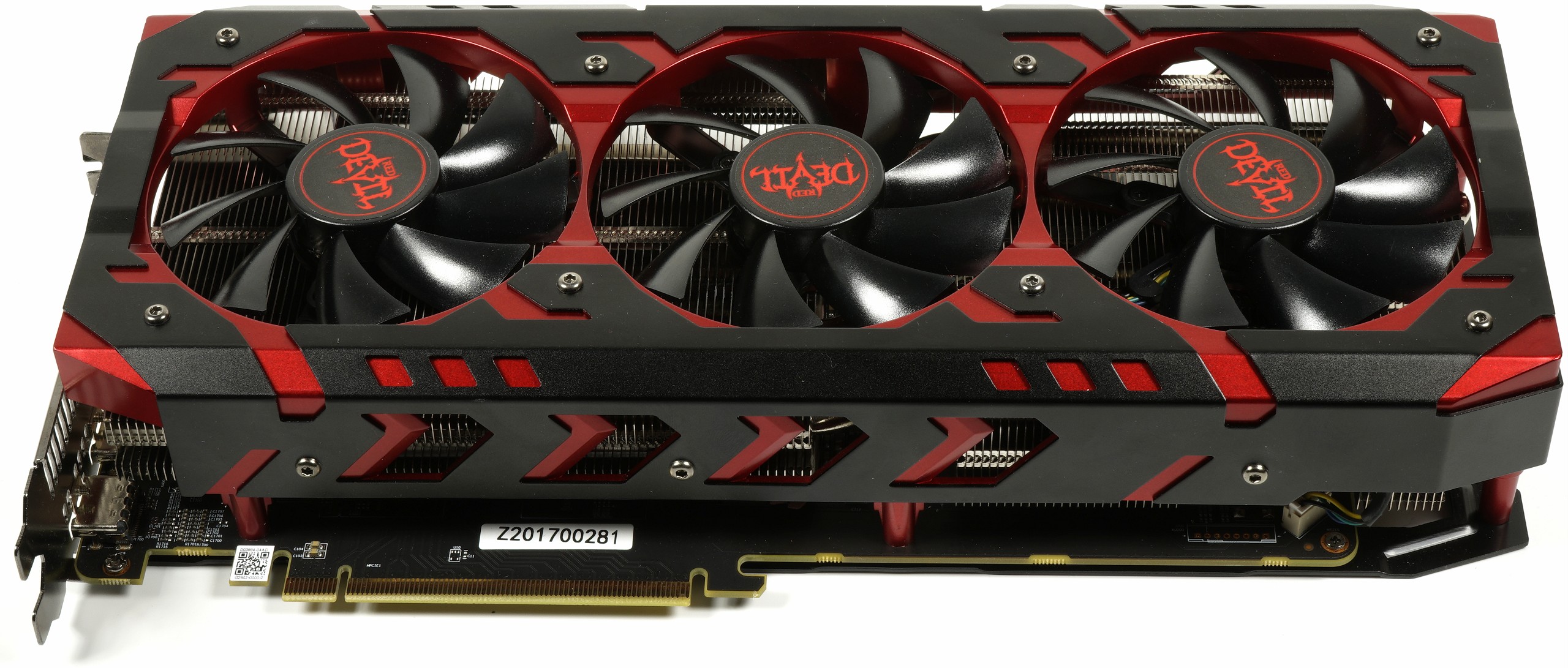
Unboxing, optics and haptics
Weighing 1409 grams, this map is only slightly below Sapphire's monstrous battleship. Powercolor has numbed the dimensions either, and like Asus, it offers a whopping 30.2 cm installation length (outer surface slot panel until the end of the radiator cover), making it a relatively long card. With a height of 12.7 cm (from the top of the motherboard lot to the top of the radiator cover, you are also just as high as Asus at the Strix, but the installation depth increases again with a whopping 5.2 cm and we already guess where the cooler will be placed.
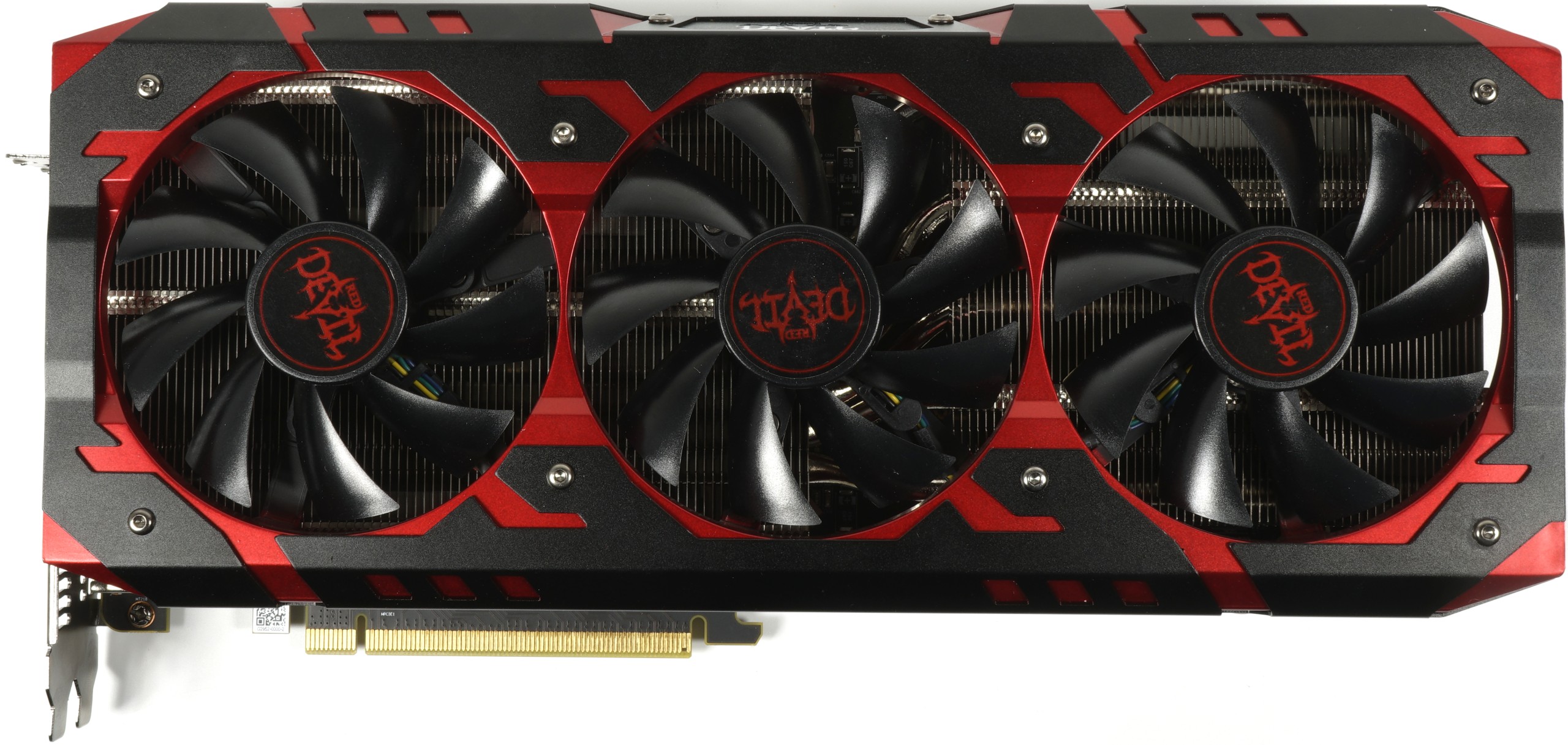
The three fans with a rotor blade diameter of 9 cm each sit in an opening with a diameter of 9.2 cm. A total of 9 rotor blades per fan, with their special shape, provide above all a strong throughput and less for turbulence; produce a little more static pressure. This should be helpful to the cooling concept and the very deep cooler.
The backplate is embossed with the printed Red Devil lettering. The backplate, which is not used for cooling, is purely optical and also stabilizes the not very light card, as well as the radiator that clearly exceeds the rear.
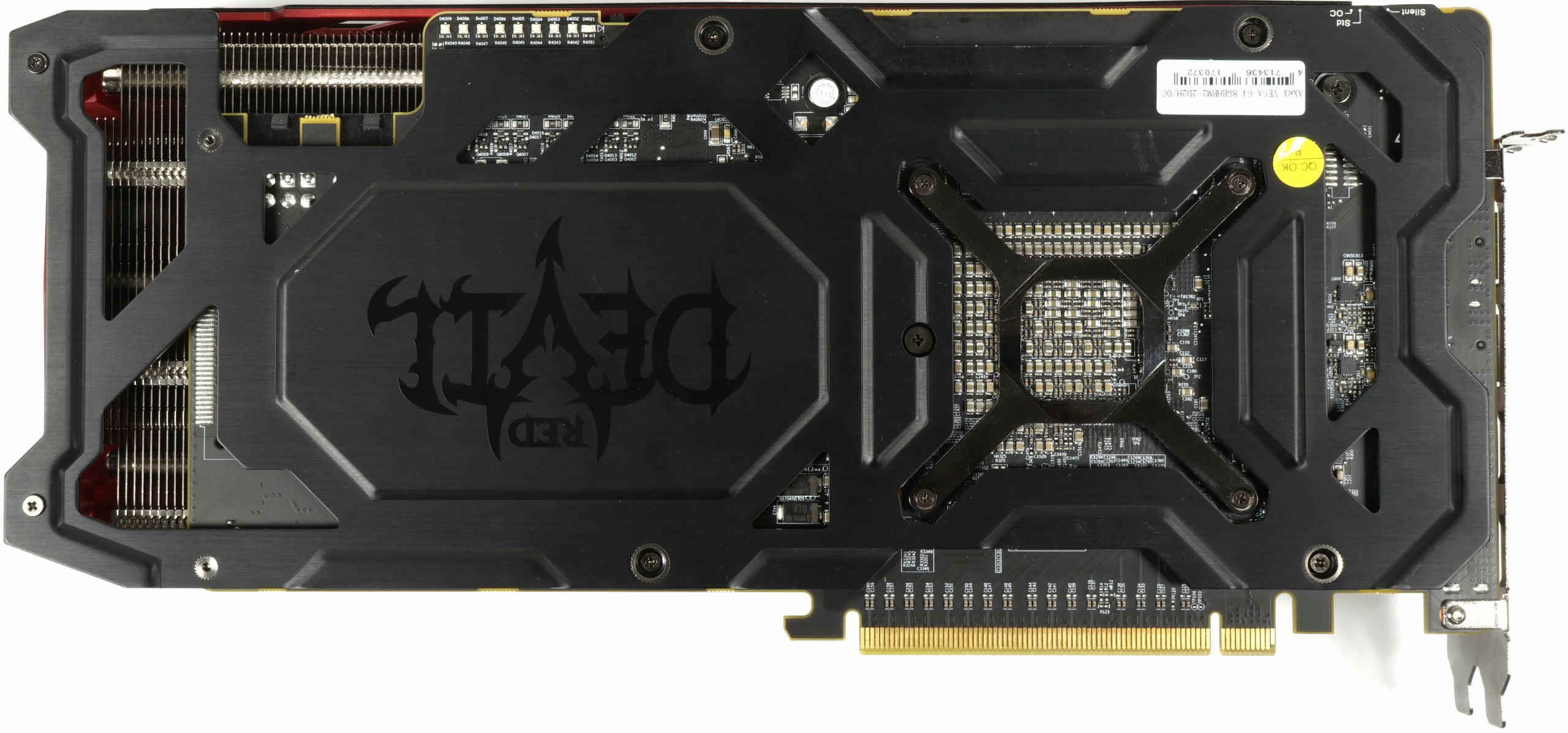
After all, one should plan at least 5 mm for the rear body, which can already lead to problems with some motherboards if heat sinks are sitting too close to the slot or the CPU cooler is extremely large.
You can already see clearly at the bottom of the card that Powercolor also relies on vertically arranged slats and again offers a real 2.5 slot model. This creates a significantly higher cooling surface, which is also gratefully accepted.

The top also clearly shows that Powercolor has remained true to the shape and design of the Red Devil. In addition to the usual dark metal cover on the red ABS shell, there is also the red-lit Red Devil lettering in the middle. In addition, the two 8-pin power supply connectors are positioned at the end of the board, which have been rotated and also moved downwards.

The almost completely closed end of the card shows not conspicuous except for the three 6 mm and an 8 mm heatpipes.
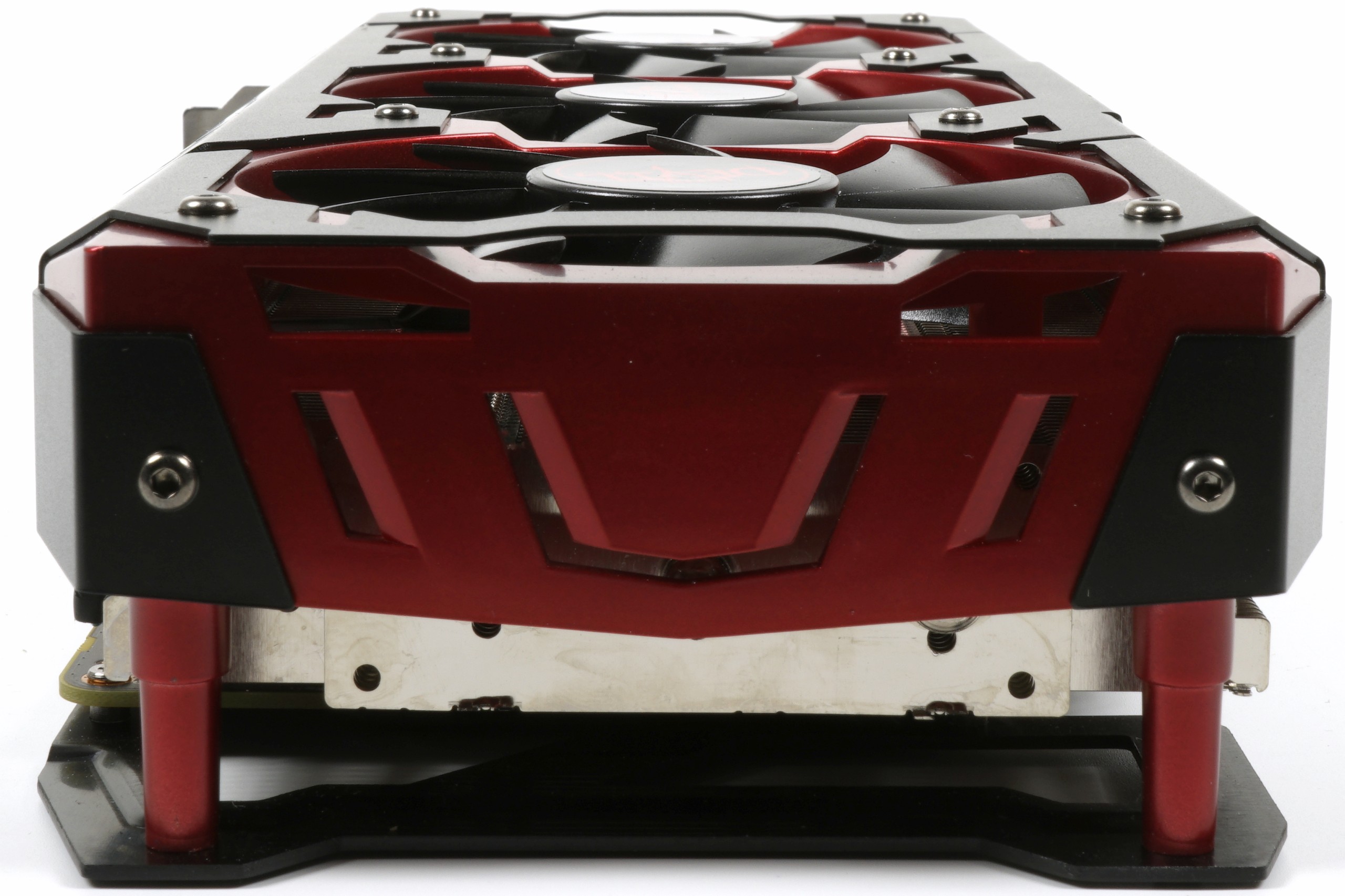
The slot panel has four instead of the five ports of the reference card. Two HDMI 2.0 ports and two DisplayPorts 1.4 are available to the user. However, the DVI-I connection is no longer necessary, for whatever reason.
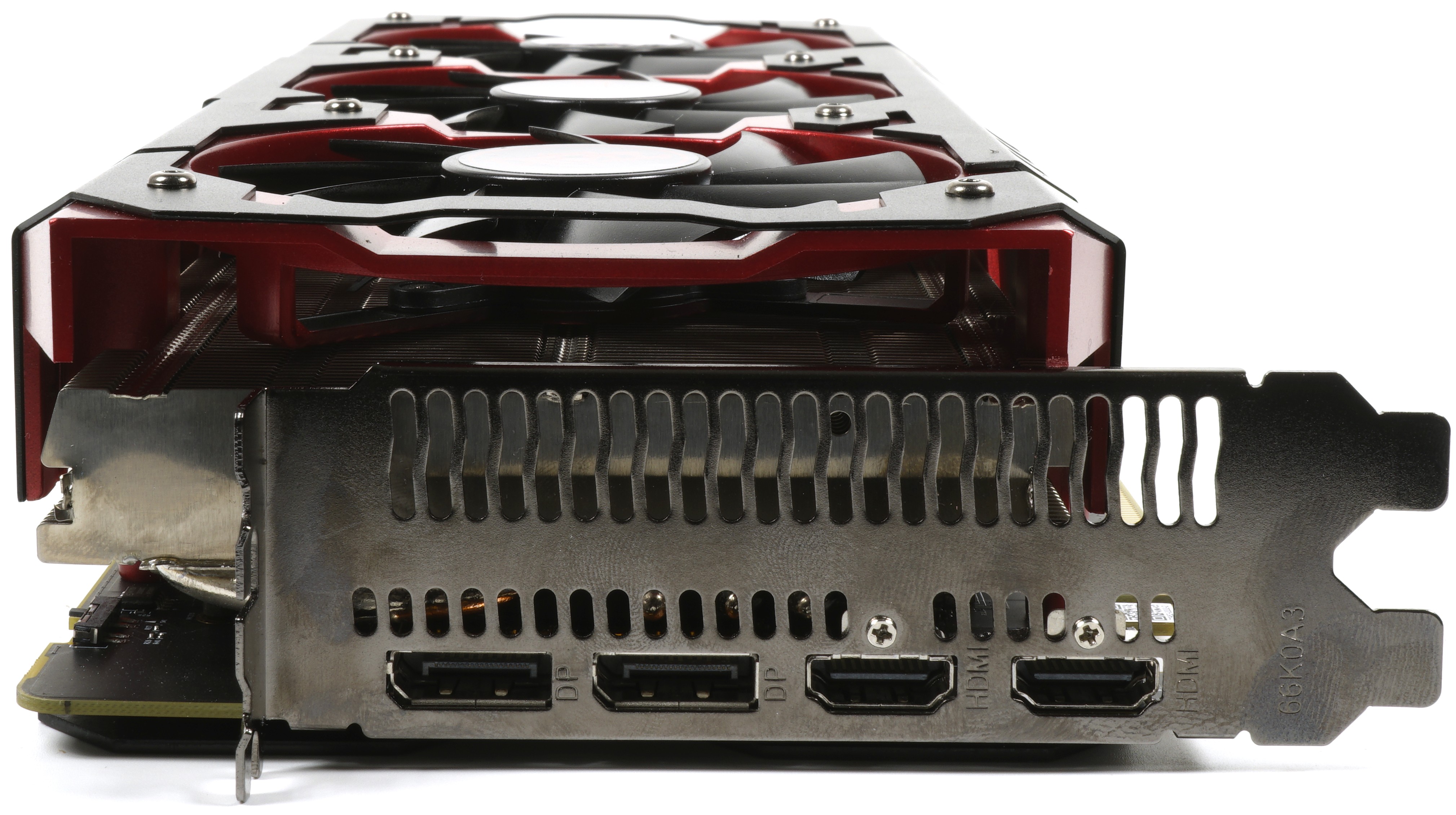
Important foreword
Unfortunately, we also need to precede a circumstance that has had some impact on our tests and the results. Although the card was marked with a manufacturer's seal, the traces of multiple use and disassembly could be clearly identified. Of course, in the end it is not a witchcraft to remove a screw with the seal by means of a suitable tool losslessly and later to use it again without traces, but as long as cards are tested in rotation, such things cannot be be excluded.
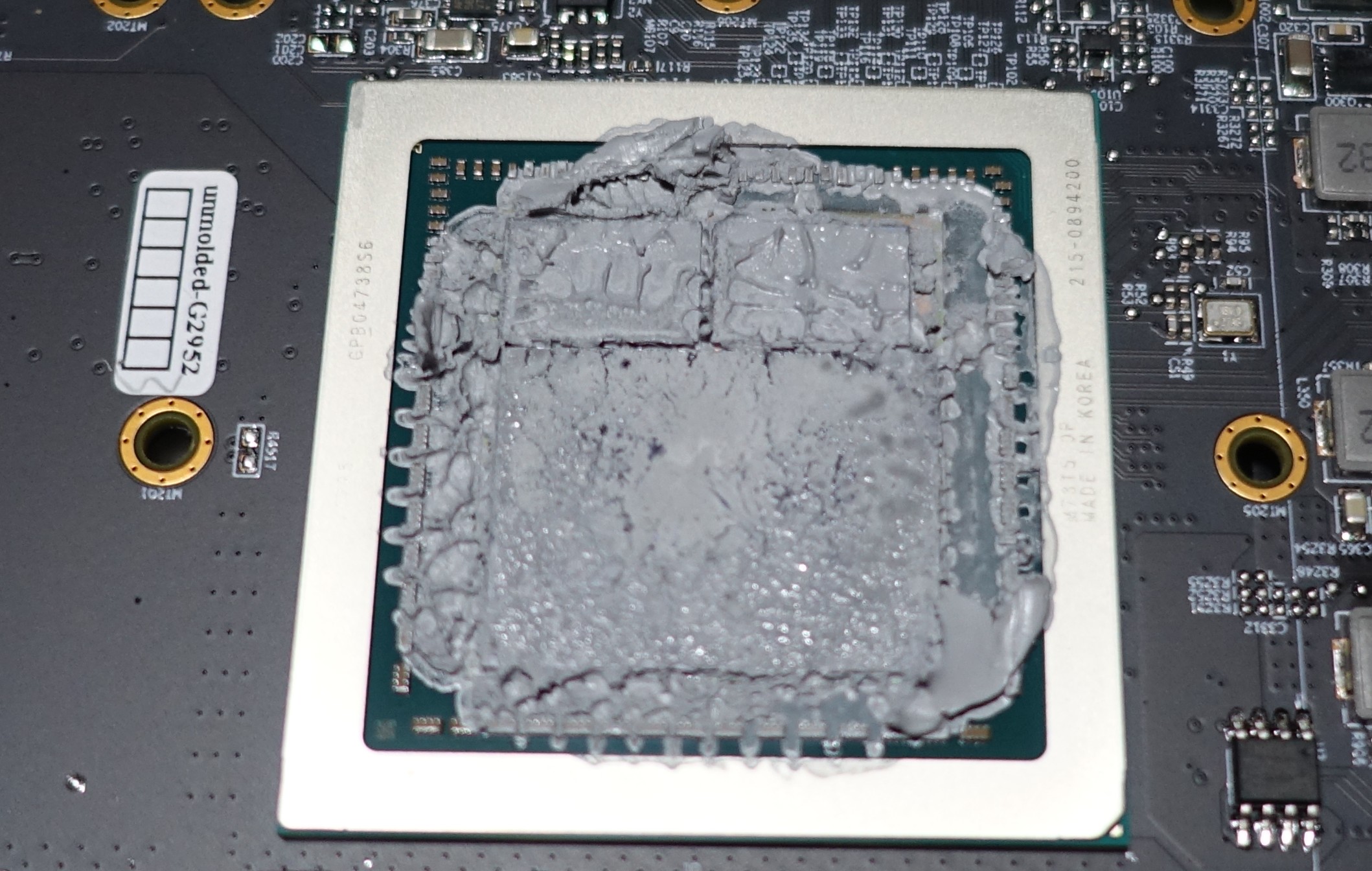 |
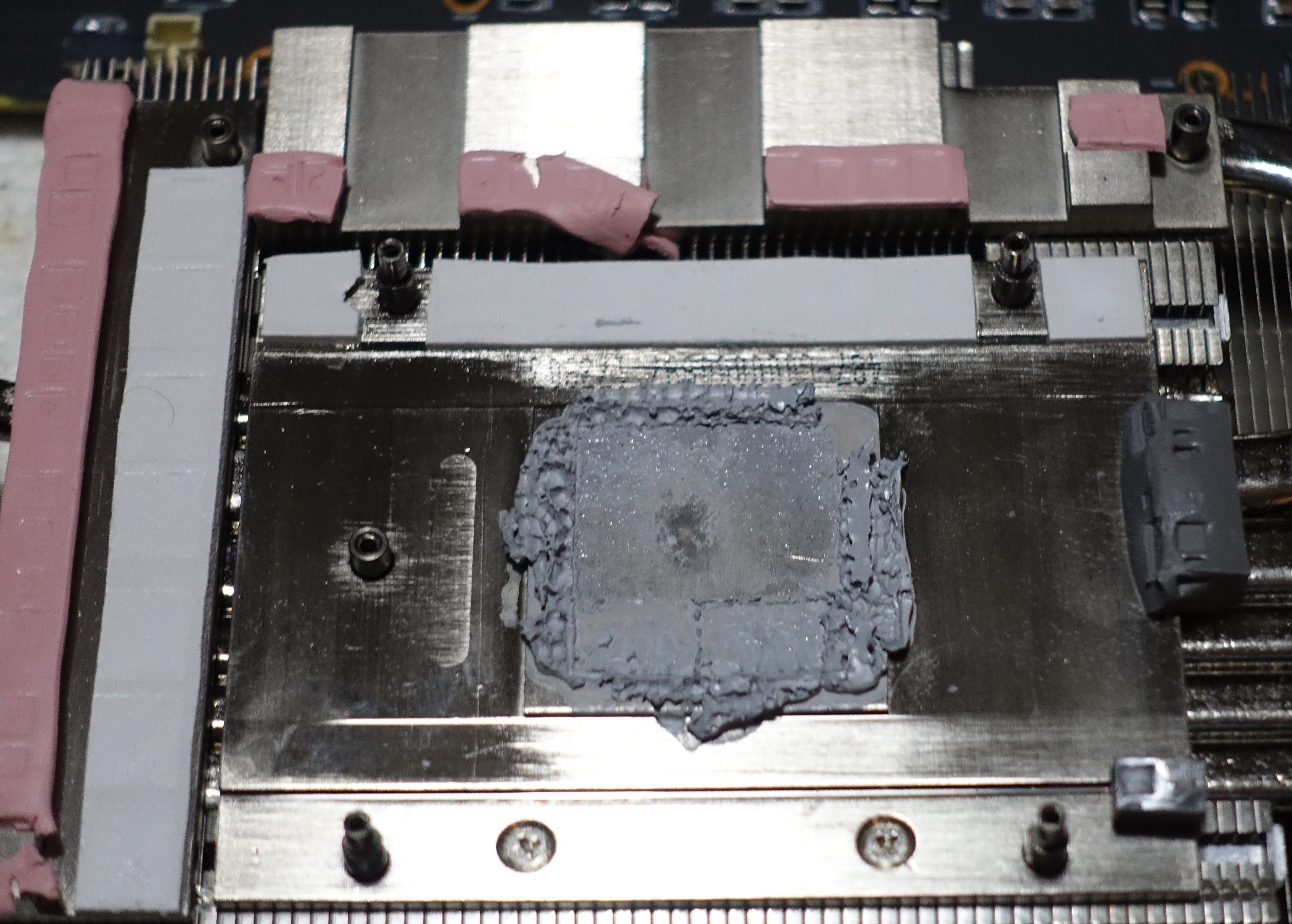 |
However, the amount of thermal paste used alone would have been easy enough for two or more cards and was downright counterproductive in the administered form. We used a very good paste as substituted, as used by the large radiator OEMs for machine application, but to a much more modest extent than in the pictures.
We have realigned the crooked and sometimes even destroyed thermal pads and partially replaced them with similar products. The reward of our repair was a 4-5 degree lower GPU temperature and significantly lower voltage converter temperatures in the range of two converters. We assume that in the end this represents the state, because a map would have had ex works.
Key technical data
Finally, let's take a first look at the purely technical data. The value displayed as the maximum boost clock, on the other hand, is rather a wishful thinking, which is unlikely to be achieved within the set power limit or at all.

Compared to the relevant reference cards, this looks like this:
| Model | Radeon RX Vega64 Reference |
Powercolor RX Vega64 Red Devil |
Radeon RX Vega56 Reference |
Geforce GTX 1070 Ti |
Geforce GTX 1080 Fe |
|---|---|---|---|---|---|
| Gpu | Vega 10 | Vega 10 | Vega 10 | GP104 | GP104 |
| Chip size | 484 mm2 | 484 mm2 | 484 mm2 | 314 mm2 | 314 mm2 |
| Transistors | 12.5 billion | 12.5 billion | 12.5 billion | 7.2 billion | 7.2 billion |
| GPU base clock/ Boost clock |
1274 MHz 1546 MHz |
1274 MHz 1630 MHz |
1156 MHz 1471 MHz |
1607 MHz 1683 MHz |
1607 MHz 1733 MHz |
| Shader/SIMD | 4096/64 | 4096/64 | 3585/56 | 2432/19 | 2560/20 |
| Texture Units/ Rops |
256 64 |
256 64 |
224 64 |
152 64 |
160 64 |
| Pixel fill rate |
99 GPix/s | 104 GPix/s | 94 GPix/s | 108 GPix/s | 114 GPix/s |
| Texture Fill Rate | 396 GTex/s | 417 GTex/s | 330 GTex/s | 244 GTex/s | 257 GTex/s |
| Memory connection | 2048 Bit | 2048 Bit | 2048 Bit | 256 bits | 256 bits |
| Storage type | HBM2 | HBM2 | HBM2 | GDDR5 | GDDR5X |
| Memory bandwidth |
484 GB/s | 484 GB/s | 410 GB/s | 256 GB/s | 320 GB/s |
| Memory clock |
1.9 Gbps | 1.9 Gbps | 1.6 Gbps | 8 Gbps | 10 Gbps |
| Storage expansion |
8 GB | 8 GB | 8 GB | 8 GB | 8 GB |
| DX Feature Level | 12_1 | 12_1 | 12_1 | 12_1 | 12_1 |
| PCIe sockets | 2 x 8-pin | 2x 8 Pin | 2 x 8-pin | 1x 8-pin | 1x 8-pin |
| Tbp | 295 watts | 283 watts | 210 watts | 180 watts | 180 watts |
Test system and measurement methods
The new test system and the methodology have already been described in great detail in the basic article "How We Test Graphics Cards" (English: "How We Test Graphics Cards") and therefore, for the sake of simplicity, we now only refer to this detailed Description. So if you want to read everything again, you are welcome to do so. However, we have again improved CPU and cooling to largely exclude possible CPU bottlenecks for this fast card.
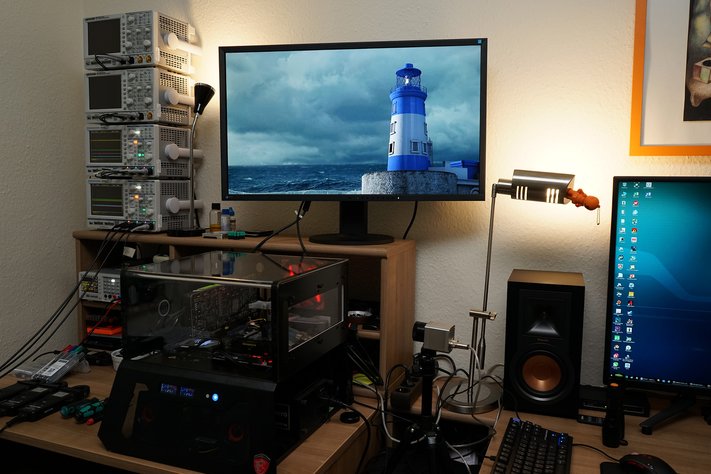
If you are interested, the summary in table form quickly provides a brief overview:
| Test systems and measuring rooms | |
|---|---|
| Hardware: |
Intel Core i7-6900K -4.3GHz MSI X99S XPower Gaming Titanium G.Skill TridentZ DDR4 3600 1x 1 TByte Toshiba OCZ RD400 (M.2, System SSD) 2x 960 GByte Toshiba OCZ TR150 (Storage, Images) Be Quiet Dark Power Pro 11, 850-watt power supply |
| Cooling: |
Alphacool Ice Block XPX 5x Be Quiet! Silent Wings 3 PWM (Closed Case Simulation) Thermal Grizzly Kryonaut (for cooler change) |
| Housing: |
Lian Li PC-T70 with expansion kit and modifications Modes: Open Benchtable, Closed Case |
| Monitor: | Eizo EV3237-BK |
| Power consumption: |
non-contact DC measurement on the PCIe slot (Riser-Card) non-contact DC measurement on the external PCIe power supply Direct voltage measurement on the respective feeders and on the power supply 2x Rohde & Schwarz HMO 3054, 500 MHz multi-channel oscillograph with memory function 4x Rohde & Schwarz HZO50, current togor adapter (1 mA to 30 A, 100 KHz, DC) 4x Rohde & Schwarz HZ355, touch divider (10:1, 500 MHz) 1x Rohde & Schwarz HMC 8012, digital multimeter with storage function |
| Thermography: |
Optris PI640, infrared camera PI Connect evaluation software with profiles |
| Acoustics: |
NTI Audio M2211 (with calibration file) Steinberg UR12 (with phantom power for the microphones) Creative X7, Smaart v.7 own low-reflection measuring room, 3.5 x 1.8 x 2.2 m (LxTxH) Axial measurements, perpendicular to the center of the sound source(s), measuring distance 50 cm Noise in dBA (Slow) as RTA measurement Frequency spectrum as a graph |
| Operating system | Windows 10 Pro (Creators Update, all updates) Radeon Software Adrenaline (17.12.2, status December 2017) |
- 1 - Einführung, Unboxing und technischen Daten
- 2 - Spannungsversorgung und detaillierte Platinenanalyse
- 3 - Gaming-Performance in WQHD (2560 x 1400 Pixel)
- 4 - Gaming-Performance in UHD (3840 x 2160 Pixel)
- 5 - Leistungsaufnahme im Detail
- 6 - Temperaturen, Taktraten, OC und Wärmebildanalyse
- 7 - Kühlerdetails und Geräuschentwicklung
- 8 - Zusammenfassung und Fazit
































Kommentieren